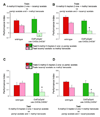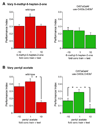Learned odor discrimination in Drosophila without combinatorial odor maps in the antennal lobe
- PMID: 18951022
- PMCID: PMC2602956
- DOI: 10.1016/j.cub.2008.08.071
Learned odor discrimination in Drosophila without combinatorial odor maps in the antennal lobe
Abstract
A unifying feature of mammalian and insect olfactory systems is that olfactory sensory neurons (OSNs) expressing the same unique odorant-receptor gene converge onto the same glomeruli in the brain [1-7]. Most odorants activate a combination of receptors and thus distinct patterns of glomeruli, forming a proposed combinatorial spatial code that could support discrimination between a large number of odorants [8-11]. OSNs also exhibit odor-evoked responses with complex temporal dynamics [11], but the contribution of this activity to behavioral odor discrimination has received little attention [12]. Here, we investigated the importance of spatial encoding in the relatively simple Drosophila antennal lobe. We show that Drosophila can learn to discriminate between two odorants with one functional class of Or83b-expressing OSNs. Furthermore, these flies encode one odorant from a mixture and cross-adapt to odorants that activate the relevant OSN class, demonstrating that they discriminate odorants by using the same OSNs. Lastly, flies with a single class of Or83b-expressing OSNs recognize a specific odorant across a range of concentration, indicating that they encode odorant identity. Therefore, flies can distinguish odorants without discrete spatial codes in the antennal lobe, implying an important role for odorant-evoked temporal dynamics in behavioral odorant discrimination.
Figures




References
-
- Ressler KJ, Sullivan SL, Buck LB. Information coding in the olfactory system: evidence for a stereotyped and highly organized epitope map in the olfactory bulb. Cell. 1994;79:1245–1255. - PubMed
-
- Vassar R, Chao SK, Sitcheran R, Nunez JM, Vosshall LB, Axel R. Topographic organization of sensory projections to the olfactory bulb. Cell. 1994;79:981–991. - PubMed
-
- Mombaerts P, Wang F, Dulac C, Chao SK, Nemes A, Mendelsohn M, Edmondson J, Axel R. Visualizing an olfactory sensory map. Cell. 1996;87:675–686. - PubMed
-
- Gao Q, Yuan B, Chess A. Convergent projections of Drosophila olfactory neurons to specific glomeruli in the antennal lobe. Nat Neurosci. 2000;3:780–785. - PubMed
-
- Vosshall LB, Wong AM, Axel R. An olfactory sensory map in the fly brain. Cell. 2000;102:147–159. - PubMed
Publication types
MeSH terms
Substances
Grants and funding
LinkOut - more resources
Full Text Sources
Other Literature Sources
Molecular Biology Databases

